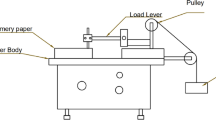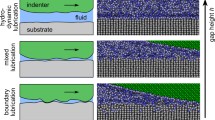Abstract
In non-conforming rolling contact, the contact stress is highly concentrated in the contact area. However, there are some limitations of the special contact model and stress model used for the theoretical study of the phenomenon, and this has prevented in-depth analysis of the associated friction, wear, and failure. This paper is particularly aimed at investigating the area of rolling contact between a sphere and a cone, for which purpose the boundary is determined by the Hertz theory and the geometries of the non-conforming surfaces. The phenomenon of stick-slip contact is observed to occur in the contact area under the condition of no-full-slip (Q < μ · P). Using the two-dimensional rolling contact theory developed by CARTER, the relative positions of the stick and slip regions and the distribution of the tangential force over the contact area are analyzed. Furthermore, each stress component is calculated based on the McEwen theory and the idea of narrow band. The stress equations for the three-dimensional rolling contact between the sphere and the cone are obtained by the principle of superposition, and are used to perform some numerical simulations. The results show that the stress components have a large gradient along the boundary between the stick and slip regions, and that the maximum stress is inversely proportional to the contact coefficient and proportional to the friction coefficient. A new method for investigating the stress during non-classical three-dimensional rolling contact is proposed as a theoretical foundation for the analysis of the associated friction, wear, and failure.
Similar content being viewed by others
References
FROLOV K V. Modern tribology: results and perspectives[M]. Moscow: LKI, 2007.
PANDIYARAJAN R, STARVIN M S, GANESH K C. Contact stress distribution of large diameter ball bearing using Hertzian elliptical contact theory[C]//Proceedings of International Conference on Modeling Optimization and Computing, Kumarakoil, INDIA, 2012, 38: 264–269.
FISCHER F D, WIEST M. Approximate analytical model for Hertzian elliptical wheel/rail or wheel/crossing contact problems[J]. Journal of Tribology, Transactions ASME, 2008, 138(4): 887–889.
ANTOINE J F, VISA C, SAUVEY C, et al. Approximate analytical model for Hertzian elliptical contact problems[J]. Journal of Tribology, Transactions ASME, 2006, 128(3): 660–664.
SACKFIELD A, HILLS D A. Some useful results in the classical Hertzian contact problem[J]. Journal of Strain Analysis for Engineering Design, 1983, 18(2): 101–105.
SACKFIELD A, HILLS D A. Some useful results in the tangentially loaded Hertzian contact problem[J]. Journal of Strain Analysis for Engineering Design, 1983, 18(2): 107–110.
ZHUPANSKA O I, ULITKO A F. Contact with friction of a rigid cylinder with an elastic half-space[J]. Journal of the Mechanics and Physics of Solids, 2005, 53(5): 975–999.
GOODMAN L E. Contact stress analysis of normally loaded rough spheres[J]. Journal of Applied Mechanics, Transactions ASME, 1962, 29(9): 515–522.
SPENCE D A. Self similar solutions to adhesive contact problems with incremental loading[C]//Proceeding of the Royal Society of London, Series A: Mathematical and Physical Sciences, London, UK, 1968, 305(1480): 55–80.
JOHNSON K L. Contact mechanics(9th printing)[M]. UK: Cambridge University Press, 2003.
SHCHERBAKOV S S. Spatial stress-strain state of tribofatigue system in roll-shaft contact zone[J]. Strength of Materials, 2013, 45(1): 35–43.
CARTER F W. On the action of locomotive driving wheel[C]//Proceedings of the Royal Society of London, London, UK, 1926, 112: 151–157.
FROMN H. Berechnung des schlupfes beim rollen deformeirbarer scheibem[J]. Zeitschrift fur Mathematik und Mechanik, 1927, 7: 27–58.
KALKER J J. Three-dimensional elastic bodies in rolling contact[M]. The Netherlands: Dordrecht, Kluwer Academic Publishers, 1990.
WANG Wenjian, GUO Jian, LIU Qiyue. Effect of track structure parameters on rolling contact stresses of wheel/rail[J]. Journal of Mechanical Engineering, 2009, 45(5): 39–44. (in Chinese)
ZHANG Shurui, LI Xia, WEN Zefeng, et al. Theory and numerical method of elastic bodies in rolling contact with curve contact area[J]. Engineering Mechanics, 2013, 30(2): 30–37. (in Chinese)
TAO Gongquan, LI Xia, WEN Zefeng, et al. Comparative analysis of two algorithms for wheel-rail contact stress[J]. Engineering Mechanics, 2013, 30(8): 229–235. (in Chinese)
LI Wei, WEN Zefeng, JIN Xuesong, et al. Numerical analysis of rolling-sliding contact with the frictional heat in rail[J]. Chinese Journal of Mechanical Engineering, 2014, 27(1): 41–49.
JIN Xuesong, WEN Zefeng, ZHANG Weihua. Analysis of contact stresses of wheel and rail with two types of profiles[J]. Journal of Mechanical Engineering, 2004, 40(2): 5–11. (in Chinese)
BOGDANSKi S, OLZAK M, STUPNICKI J. Numerical stress analysis of rolling contact fatigue cracks[J]. Wear, 2006, 191(1–2): 14–24.
WEN Zefeng, WU Lei, JIN Xuesong, et al. Three-dimensional elastic-plastic stress analysis of wheel-rail rolling contact[C]//Proceedings of the 8th International Conference on Contact Mechanics and Wear of Rail/Wheel Systems, Florence, Italy, 2011, 271(1–2): 426–436.
YANG Guoqing, HONG Jun, ZHU Linbo, et al. Three-dimensional finite element analysis of the mechanical properties of helical thread connection[J]. Chinese Journal of Mechanical Engineering, 2013, 26(3): 564–572.
DU Xiaoming, REN Jindong, SANG Chunlei et al. Simulation of the interaction between driver and seat[J]. Chinese Journal of Mechanical Engineering, 2013, 26(6): 1234–1242.
KUDRA G, AWREJCEWICZ J. Approximate modelling of resulting dry friction forces and rolling resistance for elliptic contact shape[J]. European Journal of Mechanics A-Solids, 2013, 42: 358–375.
KUMINEK T, ANIOLEK K. Methodology and verification of calculations for contact stresses in a wheel-rail system[J]. Vehicle System Dynamics, 2014, 52(1): 111–124.
AALAMI M R, ANARI A, SHAFIGHFARD T, et al. A robust finite element analysis of the rail-wheel rolling contact[J]. Advances in Mechanical Engineering, 2013, 2013: 1–9.
MAOUCHEN N, MAITOUMAM M H, VAN K D. On a new method of evaluation of the inelastic state due to moving contacts[J]. Wear, 1997, 203-204(3): 139–147.
XU Biqiang, JIANG Yanyao. Elastic-plastic finite element analysis of partial slip rolling contact[J]. Journal of Tribology, Transactions of ASME, 2002, 124(1): 20–26.
LEE D H, SEO J W, KWON S J, et al. Three-dimensional transient rolling contact analysis of similar elastic cylinders[C]//Proceedings of 11th International Conference on the Mechanical Behavior of Materials, Como, Italy, 2011, 10: 2633–2638.
ETSION I, LEVINSON O, HALPERIN G, et al. Experimental investigation of the elastic-plastic contact area and static friction of a sphere on flat[J]. Journal of Tribology, Transactions of ASME, 2005, 127(1): 47–50.
POPOV V L. Contact mechanics and friction: physical principles and applications[M]. Germany: Springer, 2011.
Author information
Authors and Affiliations
Corresponding author
Additional information
Supported by National Natural Science Foundation of China(Grant No. 51275140)
ZHAO Yanling, born in 1963, is currently a professor at School of Mechanical and Power Engineering, Harbin University of Science and Technology, China. She received her bachelor degree from Harbin Institude of Technology, China, in 1986 and received her master degree and PhD degree from Harbin University of Science and Technology, China, in 1989 and 2008, respectively. Her current research interests include friction and wear study, mechanical structure design and system dynamics.
XIA Chengtao, born in 1988, is currently a master candidate at School of Mechanical and Power Engineering, Harbin University of Science and Technology, China. He received his bachelor degree from Shandong University of Technology, China, in 2012. His research interests include elastic mechanics and contact theory.
WANG Hongbo, born in 1988, is a technologist at Shenyang Aerospace Mitsubishi Motors Engine Manufacturing Co., Ltd, China. She received her master degree from Harbin University of Science and Technology, China, in 2015. Her research interests include elastic mechanics and contact theory.
XUAN Jiaping, is currently a technologist at Shenyang Aerospace Mitsubishi Motors Engine Manufacturing Co., Ltd, China. He recieve his master degree from Harbin University of Science and Technology, China, in 2014. His research interests include dynamics simulation and numerical analysis.
XIANG Jingzhong, born in 1962, is currently a professor at School of Mechanical and Power Engineering, Harbin University of Science and Technology, China and a vice president of Mechanical Design Teaching Research Association of Heilongjiang Province, China. He received his master degree from Harbin University of Science and Technology, China, in 2003. His research interests include mechanical and electrical integration and motion control technology.
LIU Xianli, born in 1961, is currently a professor and the president at School of Mechanical and Power Engineering, Harbin University of Science and Technology, China. He received his PhD degree from Harbin Institude of Technology, China, in 1999. His research interests include clean cutting, multimedia cutting database technology and image technology.
SU Xiangguo, born in 1977, is currently an associate professor at School of Mechanical and Power Engineering, Harbin University of Science and Technology, China. He received his master degree from Harbin Institude of Technology, China, in 2000. His research interests include fatigue and failure analysis.
Rights and permissions
About this article
Cite this article
Zhao, Y., Xia, C., Wang, H. et al. Analysis and numerical simulation of rolling contact between sphere and cone. Chin. J. Mech. Eng. 28, 521–529 (2015). https://doi.org/10.3901/CJME.2015.0302.022
Received:
Revised:
Accepted:
Published:
Issue Date:
DOI: https://doi.org/10.3901/CJME.2015.0302.022




